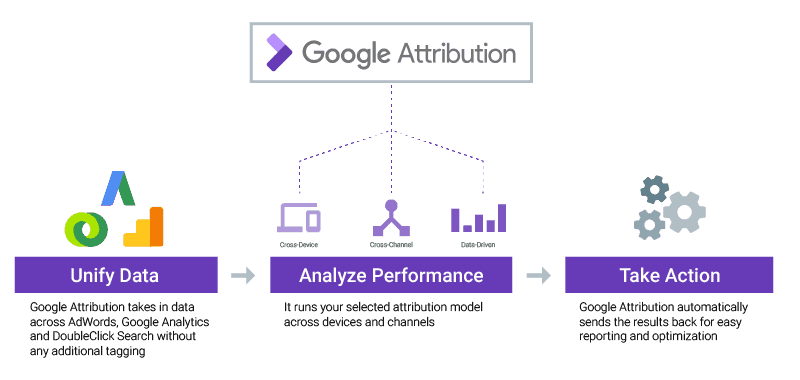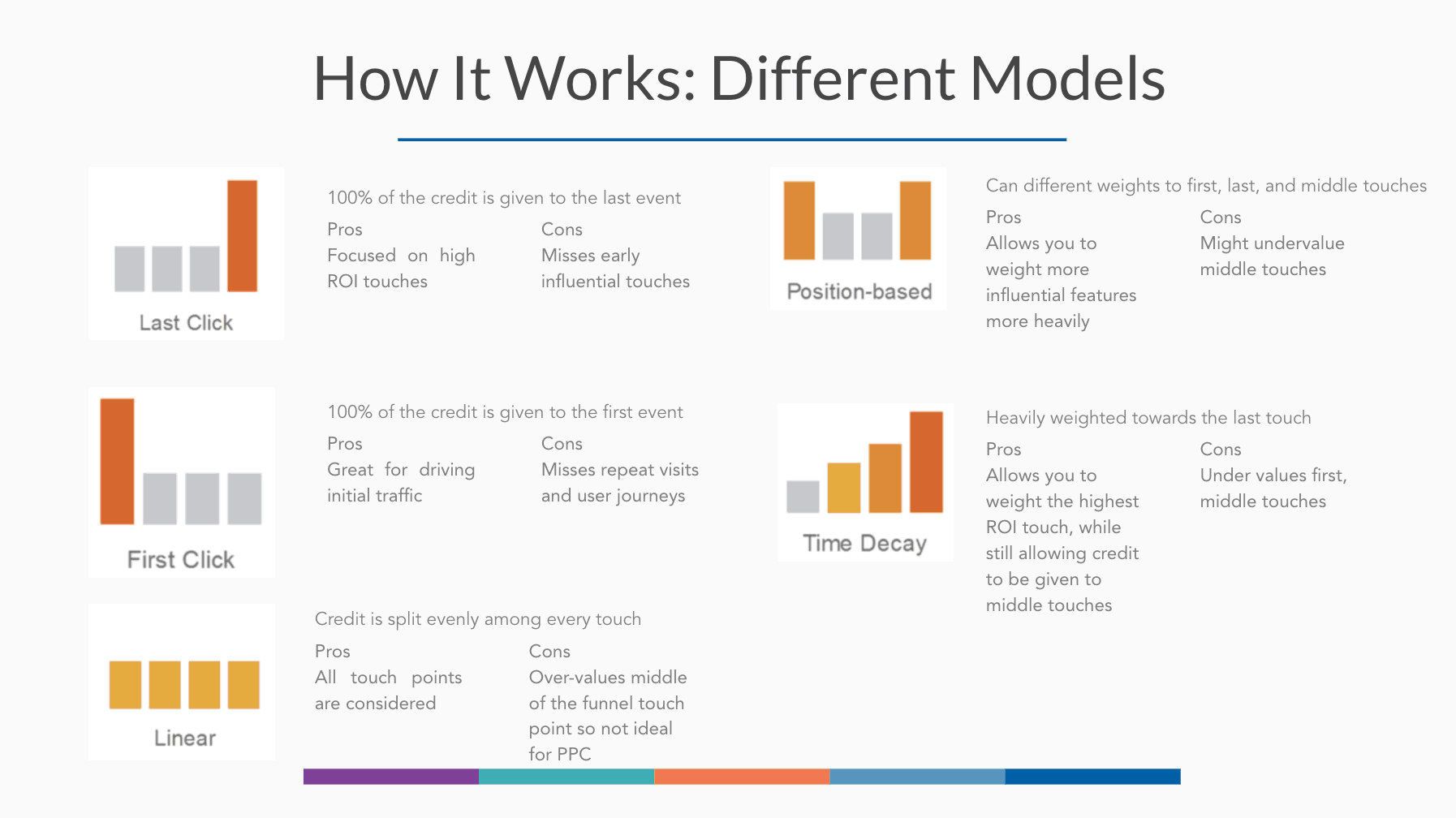What is Attribution Modeling?
A marketing attribution model is a system of quantifying the value created in each step of the customer journey. When a prospect makes a purchase, an attribution model is used to assign credit for that sale to one or more of the marketing touchpoints where the customer interacted. Attribution models help marketing teams understand the steps that customers take in the purchasing process and the touchpoints that prospects interact with as they move through the marketing funnel.
By studying how touchpoints in the marketing funnel correlate with customer behaviors, organizations can engage in strategic thinking and decision-making to improve targeting, identify the most profitable and high-impact marketing channels and optimize marketing ROI.

How Does a Marketing Attribution Model Work?
Attribution models are used to measure how events in the customer journey contribute to downstream conversion events. For organizations that leverage several marketing channels, attribution models help identify the best opportunities to trigger desired customer behaviors by allocating marketing spend to the appropriate channels or by directing the right customer to the right channel at the right time. Marketing attribution works by identifying and quantifying the relationships between marketing touchpoints and conversion events.
The first step to constructing an attribution model is defining the most important conversion events in the customer journey. A typical customer journey might consist of four major conversion events:
- First Touch – The “first touch” happens the first time a prospective customer visits our company website.
- Lead Creation – A prospect becomes a lead once they consent to be contacted by us, either by opting into an e-mail submission form, requesting a demo or a proposal, or otherwise providing us with contact information and consent to contact.
- Opportunity Creation – Once a lead has been generated, they can be contacted and qualified. Qualified leads become opportunities for the sales team.
- Customer Close – The customer close is the final conversion and the final stage in the customer journey. At the same time, the customer close represents the beginning of customer retention and opportunities for up-selling and referral sales.
Remember, this is just an example of a customer journey – yours may look a little bit different.
Once you have identified the conversion events that are most important to your customer journey, the next step is to define the marketing touchpoints that you will monitor for their impact on conversion events. A touchpoint can be defined as any interaction that a person has with your company or brand. All of the interactions that a customer has with your organization throughout the purchasing process make up the customer experience.

Some touchpoints are likely to be encountered before an initial purchase, while others will be encountered after a purchase is made. A list of possible marketing touchpoints for your organization could include:
Pre-purchase Marketing Touchpoints
- Social media advertising campaigns
- Pay-per-click advertising campaigns (Google, Facebook, etc.)
- Search engine results pages
- Print or traditional advertising
- Review or product recommendation websites
- Syndicated thought leadership content or guest blog posts from your company
- Viral videos (Facebook, YouTube)
Mid-purchase Marketing Touchpoints
- Company website
- Product catalog
- Product promotions
- Retail store or sales office
- Company sales agent
- Phone system
- Customer service department
Post-purchase Marketing Touchpoints
- Service and support departments
- Online FAQ pages
- Billing department
- Upsell messaging
- Referral Asks
Once you have defined all the marketing touchpoints that are part of the overall customer experience, you’ll need to develop some sort of data analytics capability to measure customer interactions across touchpoints and correlate them with conversion events. Your unique attribution model will determine exactly how each touchpoint is credited for its contribution to a conversion event.

Five Types of Marketing Attribution Model
Once you have defined the customer journey and the marketing touchpoints that help convert customers, an attribution model determines how each marketing touchpoint will be credited for its contribution to the end result. Marketers have developed many types of attribution models based on their unique circumstances, campaigns, product, sales strategy, and KPIs. Below, we list five of the most common single-touch and multi-touch attribution models that marketing teams can use to assign credit for conversions.
Single-touch Attribution Models
A single-touch attribution model assigns all of the credit for revenue generation to one specific touchpoint along the marketing journey.
First Touch Attribution
A first-touch attribution model assigns 100% of the credit for a conversion event to the marketing touchpoint that drove a prospective customer to your website for the first time.
Lead Creation Attribution
A lead creation attribution model assigns 100% of the credit for a conversion event to the marketing touchpoint that generates a lead for your company. To deploy this model effectively, you should develop a clear definition of what constitutes a “lead”. A lead could consist of just a name and contact information for a prospect, but it may require additional qualifying criteria before it can be considered a lead.
Last Touch Attribution
In a last-touch attribution model, the creation of a sales opportunity is attributed to the last marketing touchpoint that the prospect interacted with before the conversion happened.
Multi-touch Attribution Models
Multi-touch attribution models assign varying levels of credit to each marketing touchpoint that the customer interacts with as they move through the marketing funnel towards a purchase. Unlike the single-touch attribution models, where individual touchpoints are assigned 100% of the credit, touchpoints in a multi-touch model share credit for conversion events. Marketing touchpoints in this paradigm are seen as collectively contributing to the conversion.
Linear Attribution
Linear attribution is the most simple multi-touch attribution model. Once a customer makes a purchase, the model distributes credit evenly between all of the marketing touchpoints that the customer interacted with within their purchasing journey. If the customer was referred to the website from social media, then interacted with a white paper, a YouTube video and a sales agent, each of these touchpoints would receive equal credit for contributing to the revenue generation.
Data-Driven Attribution
Data-driven attribution uses marketing analytics and complex algorithms to produce a customized attribution model that best aligns with your unique buying process. A data-driven attribution model can help organizations determine which of their marketing efforts and touchpoints have the greatest impact on accelerating purchase behaviors, how individual touchpoints contribute to conversions and how to optimize marketing spend.
Data-driven attribution is certainly the most complex type of attribution model, but the benefit is that you’ll get the most accurate picture of how your marketing touchpoints are contributing to downstream revenue.

Directive Powers a Data-Driven Attribution Model with Closed Loop Marketing
Are you struggling to decide what attribution model to implement for your marketing efforts? At Directive Consulting, we’re experienced in choosing the best attribution model for your unique business model and deploying closed-loop analytics that tracks customer interactions across all your digital marketing touchpoints.
We can help you build an attribution model that directs your focus and marketing dollars to the most important revenue drivers for your business.
Connect with us and we’ll send you a free proposal.